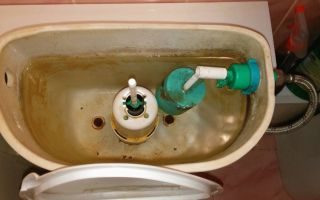Content
- 1 Features of cleaning the toilet bowl
- 2 How to open the flush tank
- 3 How to clean a toilet cistern from the inside from rust using folk methods
- 3.1 How to get rid of rust in a toilet cistern with vinegar
- 3.2 How to remove rust from a toilet cistern with citric acid
- 3.3 How to remove rust in a toilet cistern with washing powder
- 3.4 How to clean a toilet cistern from rust with electrolyte
- 3.5 How to clean a toilet cistern from limescale with soda
- 3.6 How to remove rust from a toilet cistern with toothpaste
- 3.7 How to remove rust in a toilet cistern with ammonia and peroxide
- 3.8 How to clean a toilet cistern drain with oxalic acid
- 3.9 How to clean a white toilet cistern
- 3.10 How to clean cola from a toilet cistern
- 4 How to clean the inside of the toilet cistern with specialized products
- 5 Preventing rust in the cistern
- 6 Conclusion
There are several ways to clean the inside of the toilet cistern. Household products and special chemicals allow you to remove rust and limescale on the inner walls of the tank, the procedure will not require much effort if carried out quite often.
Features of cleaning the toilet bowl
Despite the fact that the toilet is normally always closed, from time to time it still needs to be cleaned from the inside. There are several reasons for this.
- Most tap water is not of high quality and contains many mineral salts. Over time, a hard lime and rusty coating forms on the walls, which must be removed.
- If the lid is not closed tightly, then dust will inevitably penetrate through the small gaps into the tank. Over time, it also accumulates from the inside, settles on the walls and at the bottom.
- If you do not pay attention to cleaning the inside of the tank, then sooner or later, hard and soft deposits will become a source of problems. Dirt and limescale can block the drain valve or clog the drain filter, making the valve less tight against the drain hole.
In the absence of timely prevention, plumbing may break. A dirty drain tank from the inside leads to the fact that water begins to leak from under the valve or overflow through a special hole. In addition, dirty water will more quickly lead to rusty streaks on the surface of the bowl.
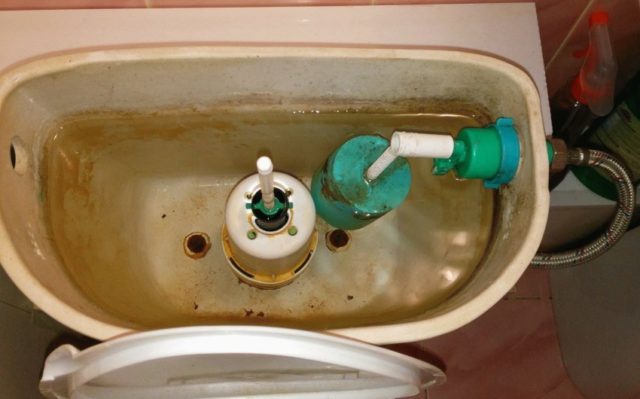
How to open the flush tank
To clean the inside of the tank, you first need to open it. This is not difficult to do, but first you need to perform other steps:
- Since after draining the water, the drain tank begins to fill with liquid again, the first step is to turn off the water. A corresponding tap is usually located at the junction of the water pipe with a flexible hose through which water flows into the tank. This valve must be turned all the way to the closed position.
- After that, the device must be emptied, that is, the water must be completely drained by pressing the release button all the way.
- Only after that you need to open the drain tank and clean it from the inside without unnecessary interference.
How exactly to open the cistern depends on the specific plumbing device. On some models, the lid just lies on top, and it is enough to gently lift it and put it aside. For others, you need to twist the drain button counterclockwise and pull it completely up.Sometimes the locking part can even be located on the side of the drain tank, but more often it is the drain button that acts as the holder.
How to clean a toilet cistern from the inside from rust using folk methods
If the revision of the inner contents of the drain tank is carried out quite often, then it can be cleaned not only with aggressive means. A good effect will be brought by ordinary household substances or mild household chemicals.
How to get rid of rust in a toilet cistern with vinegar
Table vinegar 9% has a rather aggressive composition, it is not for nothing that it is used in cooking in minimal dosages. In order to clean the inside of the plumbing, the tool fits very well, and it is used in two ways:
- a couple of glasses of table vinegar are diluted in several liters of water, then the solution is poured into the drain tank, the lid is put in place and left for a couple of hours;
- vinegar is applied to a sponge or soft rag and thoroughly wiped the walls and bottom from the inside, after which the agent is also left to soak for 40 minutes.
After the expiration of the period, the solution is drained or immediately passed along the walls from the inside with the hard side of the sponge. After treatment with vinegar, limescale can be easily cleaned.
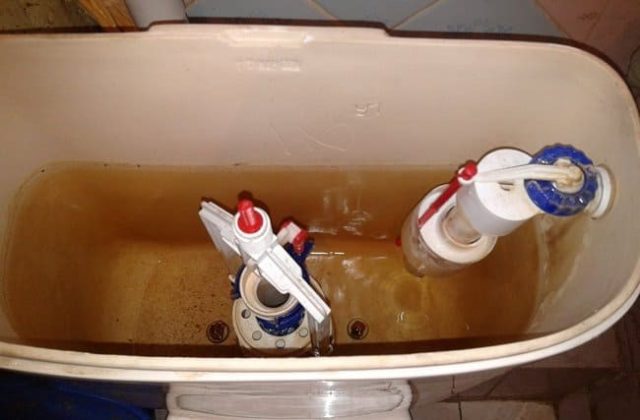
Otherwise, dirt removed from the walls can clog under the edges of the drain valve and disrupt the operation of the plumbing.
How to remove rust from a toilet cistern with citric acid
Another good remedy for removing rust and lime deposits is citric acid. Several sachets with a household product should be poured directly into the tank, pour warm water on top and stir until the crystals are completely dissolved.
Then the drain tank is covered with a lid and left for 3-4 hours, and then the water is washed off and they are trying to qualitatively clean the walls with a hard sponge or a small brush.
How to remove rust in a toilet cistern with washing powder
Washing powder helps to wash the toilet cistern inside from rust and lime; it also contains compounds that dissolve solid deposits. Use the tool like this:
- several liters of warm water are poured into an empty tank;
- pour a few tablespoons of washing powder and stir it properly;
- the cleaning mixture is left inside the tank for a couple of hours, and then washed off.
After draining the water, the walls must be cleaned with a brush or the abrasive side of a kitchen sponge, while the rust will come off quite easily.
How to clean a toilet cistern from rust with electrolyte
A good cleaning agent for toilet cisterns inside is battery electrolyte, which is often stored in men's closets. The agent must be generously applied to the walls of the tank, from which all the water is previously drained, and left for only a few minutes. After that, the plumbing should be cleaned with a brush or other brush and rinsed off with water.
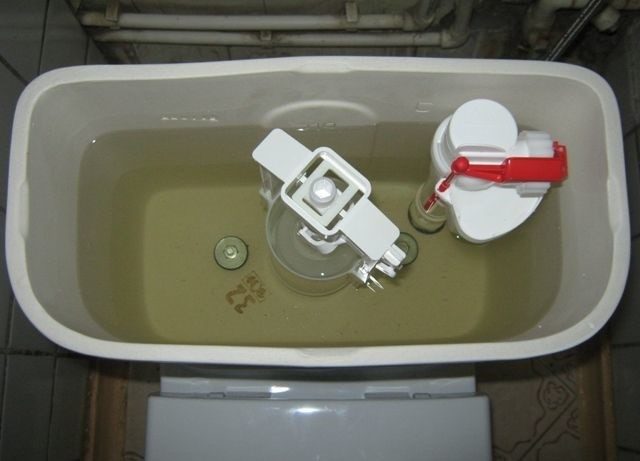
How to clean a toilet cistern from limescale with soda
Baking soda allows you to quickly clean limescale deposits from the inside of plumbing fixtures, especially if cleaning is carried out regularly and the cistern has not been properly "overgrown". Water is drained from the tank, then soda powder is diluted with a small amount of warm water so that a soft gruel is obtained. This gruel is evenly distributed over the walls and left for 30-40 minutes.
After the time has elapsed, the inside of the tank walls will need to be cleaned with a hard sponge or brush. After that, water is again drawn into the container and the drain button is pressed a couple of times.
How to remove rust from a toilet cistern with toothpaste
If the rust layer is not very dense, then you can clean the inside of the toilet cistern with ordinary toothpaste. It is used in the same way as soda - it is squeezed out of a tube and evenly distributed along the walls, and then left for 1-2 hours.
In addition, toothpaste can be used to prevent plaque build-up so that you don't need to clean your plumbing as often. In a new closed tube, several holes are made with a needle, and then the tube is placed in a filled sanitary tank. A small amount of paste will come out of the tube each time the water is flushed. As a result, rust and lime on the walls will not be deposited so quickly, and the toilet will be filled with a pleasant refreshing scent.
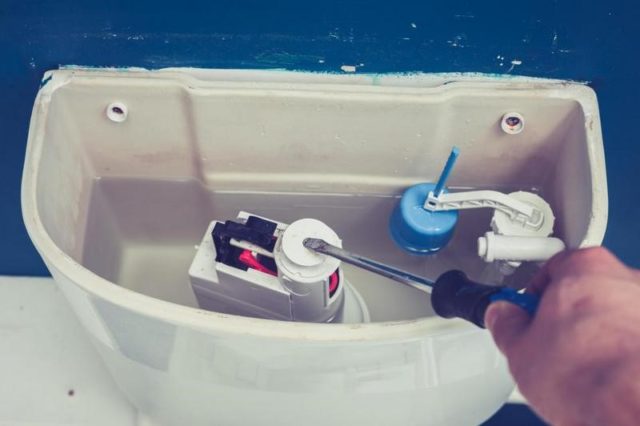
How to remove rust in a toilet cistern with ammonia and peroxide
Ammonia and hydrogen peroxide, when mixed, turn into a very effective rust cleaning agent. It is necessary to mix them in equal quantities, without diluting with water, and then gently distribute them along the walls of the drain tank using a sponge or spray bottle.
Peroxide and ammonia are allowed to attack the rust from inside the tank for 1 to 2 hours. After that, the tank is cleaned as standard with a hard sponge or brush and rinsed with water.
How to clean a toilet cistern drain with oxalic acid
If citric acid is not at hand, then oxalic acid will work just as well. Several sachets of the product must be added to the toilet bowl for cleaning and pour 4 liters of warm water, then stir well. The solution is left in the tank for several hours, and then the walls are wiped with an abrasive sponge and the acid residues are washed off with clean water.
You can also dilute oxalic acid to a slurry with a little water and apply directly to the walls with a brush. This must be done with gloves, making sure that the gruel does not get on the skin of the hands and even more so on the face. The treated tank is left for about an hour, after which its walls are cleaned from the inside in the usual way.
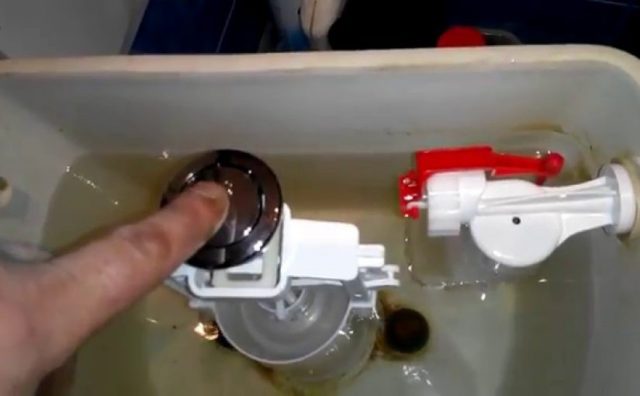
How to clean a white toilet cistern
Of the popular chemicals against rust and lime, Whiteness, a bleaching agent with an aggressive composition, works well. From inside the tank, you need to drain all the water, and then pour a bleaching agent into the toilet bowl against rust, the walls and bottom are generously treated with whiteness. Leave the Whiteness inside for about 30 minutes, and then clean the inside of the container with a stiff brush and rinse with clean liquid.
How to clean cola from a toilet cistern
An unconventional but effective way to clean the cistern is an ordinary "Coca Cola". Soda can be an excellent solvent for deposits. A few liters of "Cola" should be poured into the empty tank and left for 1-1.5 hours, after which the surface should be cleaned from the inside with a hard washcloth or brush. Coca-Cola works especially well against minor plaque and rust.
How to clean the inside of the toilet cistern with specialized products
If the inside of the drain tank has not been cleaned for a very long time, and a lot of deposits have accumulated, household home remedies may not bring the desired effect. In such cases, it makes sense to use specialized chemistry. Among the effective chemical solutions include:
- Domestos - the product removes well both fresh and old deposits and rusty deposits;
- Sillit- acid-containing gel copes especially well with old deposits on the walls of the drain tank;
- Sanox - the product belongs to the budget category, but it helps well to clean solid deposits from the inside and, moreover, has a rather pleasant smell.
These and other specialized tools are used in the same way. All water is removed from the drain tank, and then the gel is applied to the bottom and distributed along the walls with a hard sponge. In order for the funds to work in full force, they must be left inside for at least 30-40 minutes, and even better for 1-1.5 hours.

After the specified time has elapsed, the ceramic walls will need to be properly cleaned with a brush, then pour water and drain it 3-4 times in a row. If it is not possible to clean the entire plaque the first time, then the procedure can be repeated; in several applications, specialized gels are guaranteed to eliminate rust and plaque from the inside of the tank.
Preventing rust in the cistern
So that the fight against rust and plaque from the inside does not take much effort, it is recommended:
- use special tablets and cassettes designed to soften and purify water - they are put directly into the drain tank, as a result of deposits do not appear so quickly;
- monitor the condition of the water pipes, if the latter can be called emergency, then the water in them, by definition, is harder and contains more impurities;
- find time to clean the inside of the plumbing for preventive purposes at least once every six months, even if rust and plaque has not yet appeared on the walls of the tank.
Prevention of plaque and rust helps prevent leaking plumbing and premature wear of drain fittings and filter. If you regularly take the time to clean the drain tank, then as a result, using the toilet will be more pleasant, and you will not have to think about repairing it very long.
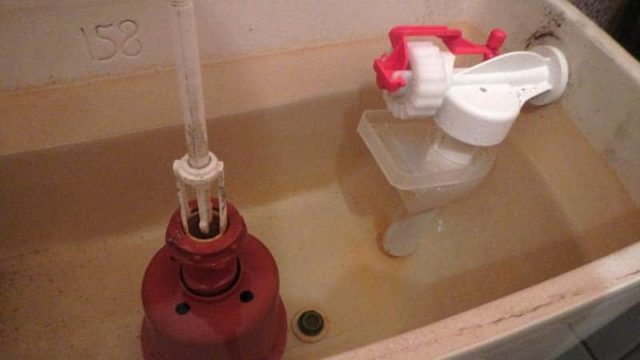
Conclusion
You can clean the inside of the toilet cistern with household alkaline and acidic products, as well as special gels from the hardware store. It is important to carry out preventive cleaning regularly so that dirt, in principle, does not accumulate on the walls of the tank, then it will be easier to deal with them.

